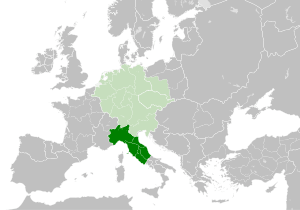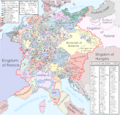Kingdom of Italy (Holy Roman Empire) facts for kids
The Kingdom of Italy was an important part of the Holy Roman Empire. It was like one of the main countries within this big empire. Its name in Latin was Regnum Italiae.
This kingdom covered most of northern Italy and central Italy. However, it did not include the Republic of Venice. The first capital city of the Kingdom of Italy was Pavia.
Contents
How the Kingdom of Italy Began
In the year 773, a powerful ruler named Charlemagne was the King of the Franks. He led his army across the Alps mountains. His goal was to invade the Kingdom of the Lombards. This Lombard kingdom controlled almost all of Italy at that time.
By June 774, the Lombard kingdom had fallen. Charlemagne and his Frankish army took control of northern Italy. Some southern areas of Italy stayed under Lombard rule. Charlemagne then took on a new title: "King of the Lombards."
In the year 800, Charlemagne was crowned "Emperor of the Romans" in Rome. His family, the Carolingian dynasty, ruled Italy for many years. After 887, different noble families fought for control of Italy. This made the kingdom unstable for a while.
Joining the Holy Roman Empire
In 961, a German king named Otto I the Great invaded Italy. He was already married to Adelaide of Italy, who was the widow of a previous Italian king. Otto I was crowned king in Pavia on December 25th.
He then traveled to Rome and was crowned emperor on February 7th, 962. This event was very important. It officially joined the crowns of Italy and Germany. This new, larger empire eventually became known as the "Holy Roman Empire."
From 961 onwards, the Emperor of the Romans was usually also the King of Italy and Germany. Sometimes, emperors would let their children rule Italy. Other times, Italian nobles and bishops would choose their own king.
Italian City-States and Conflicts
Because the emperor was often away in Germany, the central government in Italy became weak. However, the idea that Italy was a kingdom within the Empire remained. Emperors often tried to control the growing Italian city-states.
This led to many wars and conflicts. Two main groups fought against each other:
- The Guelphs were against the emperor's power.
- The Ghibellines supported the emperor.
These fights were a big part of Italian politics from the 12th to the 14th centuries. A famous example was the Lombard League. This group of cities openly challenged the emperor's power. They were not trying to separate from the empire, but they wanted more freedom.
The End of the Kingdom
By the 15th century, the power of the city-states had largely faded. A series of wars in Lombardy from 1423 to 1454 reduced the number of powerful states in Italy. After about 40 years of peace, France invaded Italy in 1494.
These conflicts, known as the Great Italian Wars, lasted until 1559. After these wars, much of Italy came under the control of King Philip II of Spain.
The Peace of Westphalia in 1648 officially ended the Holy Roman Emperors' direct rule in Italy. However, the Spanish branch of the House of Habsburg family continued to rule most of Italy. This lasted until the War of the Spanish Succession (1701–1714).
The Habsburg rule in Italy finally ended with the French Revolutionary Wars (1792–1797). During this time, new republics were set up in Italy. In 1806, the Holy Roman Empire was officially dissolved by Francis II, Holy Roman Emperor, after his defeat by Napoleon.
Images for kids
See also
 In Spanish: Reino de Italia (Sacro Imperio Romano Germánico) para niños
In Spanish: Reino de Italia (Sacro Imperio Romano Germánico) para niños





